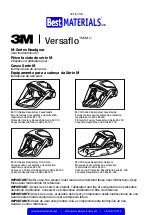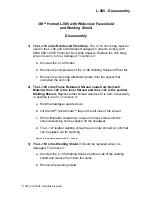
shooting procedures listed below. Refer to the wir-
ing diagram at the end of this book.
Perform the troubleshooting test procedures in
the listed sequence. Each test presumes the compo-
nents tested in the earlier steps are working prop-
erly. The tests can yield invalid results if they are
performed out of sequence. If a test indicates that a
component is working properly, reconnect the elec-
trical connections and proceed to the next step.
1. Inspect the main fuse and the carburetor fuse as
described in Chapter Nine.
2. Check the battery as described in Chapter Three.
3. Check the continuity of the main switch (Chap-
ter Nine).
4. Check the continuity of the neutral switch
(Chapter Nine).
5. On Europe and Australia models, test the carbu-
retor heater relay (Chapter Eight).
6. Test the thermoswitch (Chapter Eight).
7. Test the carburetor heater (Chapter Eight).
8. Check the carburetor heating system wiring and
connectors. Repair as necessary.
FUEL PUMP
When troubleshooting a fuel pump problem, first
perform the fuel pump operational test described in
Chapter Eight. If the fuel pump is operational, the
problem is in the fuel pump system circuit. Trouble-
shoot the circuit by following the fuel pump circuit
troubleshooting procedures listed below. Refer to
the wiring diagram at the end of this book.
Fuel Pump Circuit
Troubleshooting
Perform these test procedures in the listed se-
quence. Each test presumes the components tested
in the earlier steps are working properly. The tests
can yield invalid results if they are performed out of
sequence. If a test indicates that a component is
working properly, reconnect the electrical connec-
tions and proceed to the next step.
1. Inspect the main fuse and the ignition fuse as de-
scribed Chapter Nine.
2. Check the battery (Chapter Three).
3. Check the continuity of the main switch (Chap-
ter Nine).
4. Check the continuity of the engine stop switch
(Chapter Nine).
5. Check the fuel pump relay in the starting circuit
cutoff relay (Chapter Eight).
6. Check the resistance of the fuel pump (Chapter
Eight).
7. Check the fuel system wiring and all connectors.
Repair as necessary.
ELECTRICAL TESTING
This section describes the basics of electrical test-
ing and the use of test equipment.
Preliminary Checks and Precautions
Prior to starting any electrical troubleshooting
perform the following:
1. Check the main fuse (Chapter Nine). If the fuse
is blown, replace it.
2. Check the individual fuses mounted in the fuse
box (Chapter Nine). Inspect the suspected fuse, and
replace it if it is blown.
3. Inspect the battery (Chapter Three). Make sure it
is fully charged, and the battery leads are clean and
securely attached to the battery terminals.
4. Disconnect each electrical connector in the sus-
pect circuit and make sure there are no bent metal
terminals inside the electrical connector (
Figure 7
).
A bent terminal will not connect to its mate in the
other connector, causing an open circuit.
5. Make sure the terminals on the end of each wire
(
Figure 8
) are pushed all the way into the
connector. If not, carefully push them in with a nar-
row blade screwdriver.
TROUBLESHOOTING
47
2
8
Loose terminal
















































